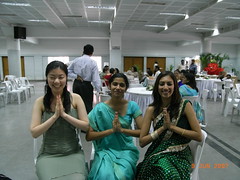Namasté, Namaskar or Namaskaram (Sanskrit: नमस्ते [nʌmʌsˈteː] from external sandhi between namaḥ and te) is a common spoken greeting or salutation in the Indian subcontinent, says Wikipedia. Taken literally, it means "I bow to you". The word is derived from Sanskrit (namas): to bow, obeisance, reverential salutation, and (te): "to you".[1] Namaskar is considered a slightly more formal version than namasté but both express deep respect.
It is commonly used in India and Nepal by Hindus, Jains and Buddhists, and many continue to use this outside the Indian subcontinent.
When spoken to another person, it is commonly accompanied by a slight bow made with hands pressed together, palms touching and fingers pointed upwards, in front of the chest. The gesture can also be performed wordlessly and carry the same meaning.
In Indian and Nepali culture, the word is spoken at the beginning of written or verbal communication. However, upon departure the only the wordless hands-folded gesture is made.
In yoga, namasté is said to mean "The light in me honors the light in you," as spoken by both the yoga instructor and yoga students.
Thursday, February 26, 2009
Subscribe to:
Post Comments (Atom)


No comments:
Post a Comment